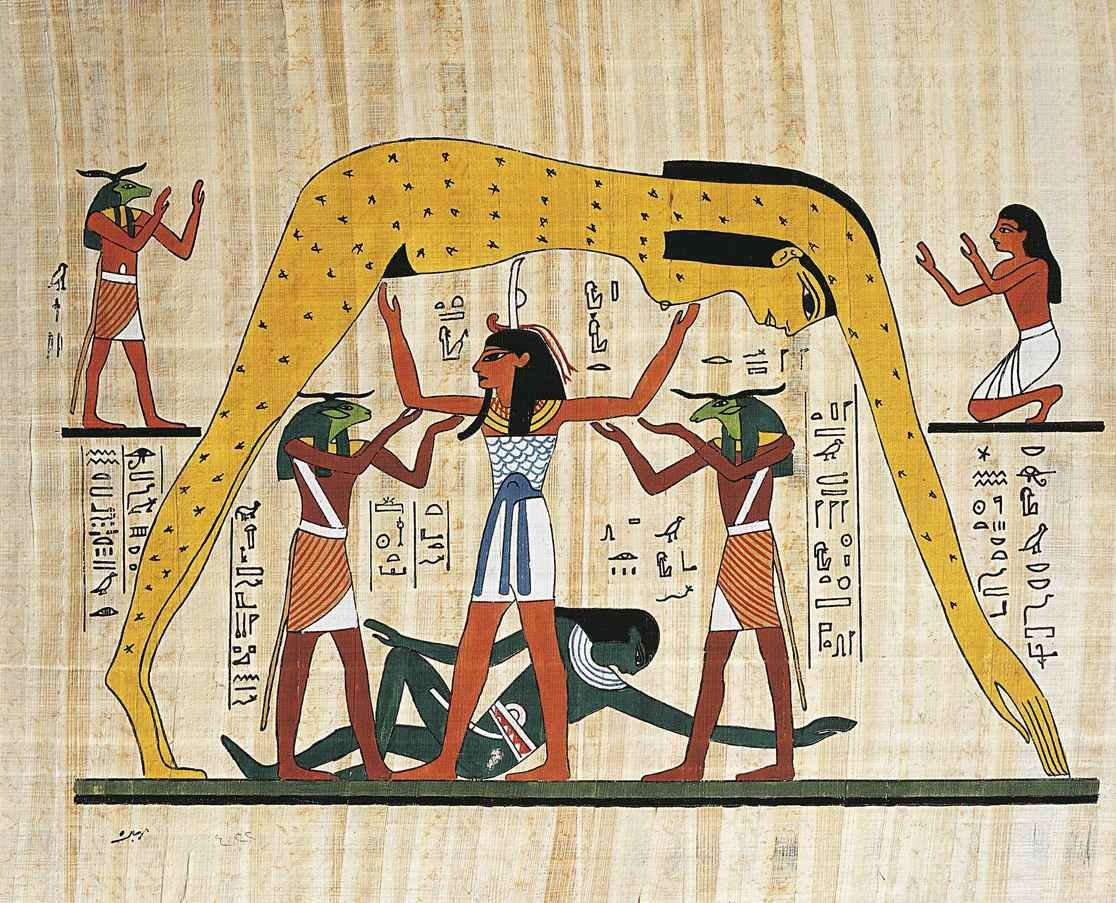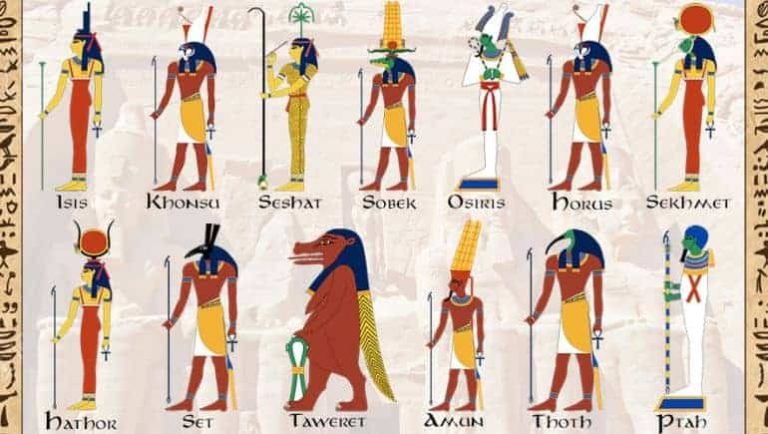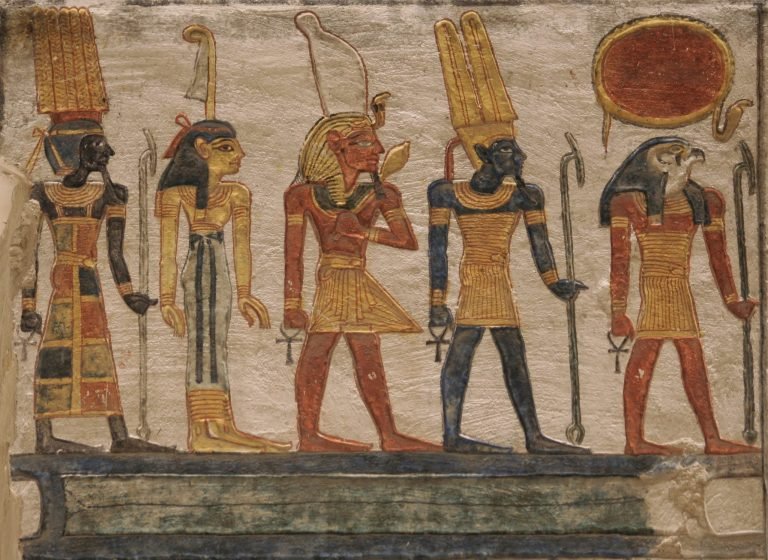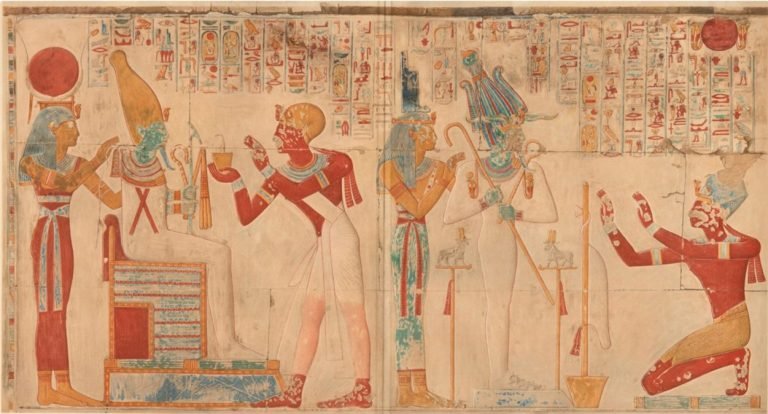The world of the Egyptian Gods offers a profound glimpse into ancient Egyptian mythology and one of history’s most enduring civilizations.
Indeed, storytellers and priests wove an intricate tapestry of tales and legends around these pivotal deities, which, over time, evolved over thousands of years along the Nile.
These Egyptian Gods and goddesses, consequently, stand at the heart of this narrative; ancient Egyptians revered them as divine beings wielding immense power over the cosmos and mortal affairs.
Therefore, understanding these significant Egyptian Gods provides key insights into the spiritual beliefs and cultural ethos of ancient Egypt, revealing how this civilization perceived the world.”
The Pantheon: Exploring Key Egyptian Gods
The ancient Egyptian pantheon is vast and complex. To begin with, Below, we explore some of the most prominent and influential Egyptian Gods, whose stories and symbolism have captivated humanity for millennia and offer a window into the values and worldview of this fascinating culture.
Ra: The Majestic Sun God and Supreme Creator
Dominating the Egyptian pantheon is Ra (or Re), the radiant Sun God and often revered as the supreme creator. Ancient Egyptians believed Ra traversed the daytime sky in a solar barque (his sun boat), descending into the underworld at night to battle chaos before being reborn each morning.
This journey symbolized the eternal cycle of birth, death, and rebirth. As the quintessential bringer of light, warmth, and life, Ra was fervently worshipped across Egypt, with magnificent temples, like those at Heliopolis and Karnak (through his syncretism with Amun as Amun-Ra), dedicated in his honor.
His influence permeated every aspect of Egyptian life, making him a central figure in their cosmology.
Osiris: Benevolent God of the Afterlife and Resurrection
Next, Osiris reigns as the benevolent ruler of the Duat (the underworld), guiding the souls of the deceased on their perilous journey toward judgment and eternal life.
However, his envious brother Seth famously murdered him, and his devoted wife Isis magically restored him. As a result, Osiris became a powerful symbol of resurrection, renewal, and the cyclical nature of existence. For ancient Egyptians, death was not a definitive end; rather, it was a crucial transition. Thus, Osiris’s story offered hope and a framework for understanding life’s continuity beyond the mortal realm, promising rebirth for those who lived justly. In addition, he also held sway as a god of fertility and agriculture, an association linked to the Nile’s annual, life-giving flood.
Isis: Mistress of Magic, Motherhood, and Healing
The enchanting goddess Isis likewise captivated the hearts and minds of ancient Egyptians with her boundless compassion, fierce devotion, and mastery of magic and healing.
As the loyal consort of Osiris and the protective mother of Horus, Isis therefore embodied the nurturing essence of femininity, the strength of motherhood, and the transformative power of love and loyalty. Her potent spells, for example, proved instrumental in resurrecting Osiris and protecting Horus from Seth.
Consequently, Ancient Egyptians widely worshipped Isis, and her cult subsequently spread throughout the Greco-Roman world, where diverse peoples also revered her as a universal mother goddess.
Horus: The Valiant Avenger and Divine Protector of Pharaohs
Horus, the valiant falcon-headed god, is a pivotal figure in Egyptian mythology, celebrated primarily as the avenger of his father, Osiris. He embarked on a series of epic struggles against his treacherous uncle, Set, to reclaim the throne of Egypt and restore order (Ma’at) over chaos.
The iconic Eye of Horus (Wedjat eye) became a powerful symbol of protection, healing, and royal power. The pharaohs of Egypt were considered the living embodiment of Horus, the divine protector tasked with ensuring the kingdom’s prosperity, stability, and justice.
Anubis: Guardian of the Dead and Master of Mummification
Anubis, typically depicted with the head of a jackal or wild dog, presided over the sacred and solemn rites of mummification and embalming. As the “Guardian of the Scales,” Anubis played a crucial role in the Weighing of the Heart ceremony, where the deceased’s heart was weighed against Ma’at’s feather of truth to determine their worthiness for the afterlife. With his keen oversight and unwavering vigilance, Anubis safeguarded the sanctity of burial rites, ensuring the soul’s safe passage to the judgment hall of Osiris and into the underworld.
Seth: The Tumultuous God of Chaos, Storms, and the Desert
In stark contrast to the generally benevolent deities of the Egyptian pantheon stands Seth (or Set), the formidable and often tumultuous god of chaos, violence, desert storms, and foreigners. Often depicted with the head of a mysterious, unidentifiable creature (the “Set animal” or “Typhonic beast”), Seth embodied the untamed, unpredictable, and often destructive forces of nature. While he was the murderer of Osiris and the rival of Horus, Seth also played a protective role, defending Ra’s solar barque from the serpent Apophis during its nightly journey through the underworld. His character reflects the ancient Egyptian understanding of the necessary balance between order and disorder.
Ma’at: Goddess of Truth, Balance, and Cosmic Order
Finally, Ma’at, the serene and graceful goddess, personified the essential concepts of truth, balance, justice, harmony, and cosmic order. In essence, she governed the universe’s equilibrium, ensuring harmony among gods and mortals alike. An ostrich feather represented Ma’at, and significantly, this Feather of Ma’at featured in the afterlife judgment ceremony where Anubis weighed the heart. Because of this, Ancient Egyptians believed that adherence to Ma’at’s principles maintained cosmic balance, upheld society’s moral fabric, and ensured an individual’s passage to a blessed afterlife.
Conclusion: The Timeless Majesty of the Egyptian God
In summary, as we conclude this journey through their mythical realm, the profound and enduring legacy of the Egyptian Gods stands undeniable. From the sun-soaked majesty of Ra and the magical devotion of Isis, to the orderly principles of Ma’at that guided their civilization, indeed, these deities collectively paint a vivid picture of ancient Egyptian belief. Furthermore, the rich mythology surrounding the Egyptian Gods reflects the core aspirations, fears, and values of that grand civilization. Consequently, their fascinating stories continue to inspire awe and scholarly interest worldwide, weaving themselves into the fabric of human consciousness and echoing through history.





0 Comment